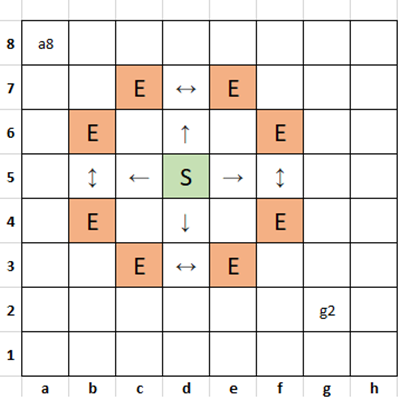PWC 292-1
PWC 291-1
PWC 290
PWC 289
PWC 288
PWC 287
PWC 285
PWC 284
PWC 283-1
PWC 283
PWC 282
PWC 281
PWC 280
PWC 279
PWC 278
PWC 277
PWC 276
PWC 275
PWC 273
PWC 272
PWC 271
PWC 270
PWC 269
PWC 268
PWC 267
PWC 266
PWC 265
PWC 264
PWC 263
PWC 262
PWC 261
PWC 260
PWC 258
PWC 255
PWC 239
...under construction...
The Weekly Challenge - 281
TASK #1: Check Color
You are given coordinates, a string that represents the coordinates of a square of the chessboard as shown below:

Write a script to return true if the square is light, and false if the square is dark.
#!/usr/bin/perl use strict; use warnings; =begin Light fields are created by combining the column letters b, d, f, h and the odd row numbers 1, 3, 5, 7, or the column letters a, c, e, g and the even row numbers 2, 4, 6, 8. When representing the letters by their numeric ASCII codes and adding these to the row numbers, the result is always an odd number. Example: b1 -> 98 + 1 = 99 -> odd -> light field =cut # Solution sub get_field_color {# Split the field notation into column and row my ($col, $row) = ($_[0] =~ /([a-h])([1-8])/);# Ensure the input is valid return("invalid field\n") unless (defined $col) && (defined $row);# Convert column letter to the numeric ASCII value # and add this number to the row number ( ( ord($col) + $row ) % 2 != 0 ) ? return("true\n")# light : return("false\n");# dark } # Tests my $field; # Example 1 $field = "d3"; print(get_field_color($field));# Output: true # Example 2 $field = "g5"; print(get_field_color($field));# Output: false # Example 3 $field = "e6"; print(get_field_color($field));# Output: true # Example 4 $field = "z8"; print(get_field_color($field));# Output: invalid field
TASK #2: Knight’s Move
A Knight in chess can move from its current position to any square two rows or columns plus one column or row away. So in the diagram below, if it starts a S, it can move to any of the squares marked E.

Write a script which takes a starting position and an ending position and calculates the least number of moves required.
#!/usr/bin/perl use strict; use warnings; =begin BFS (Breadth-First Search) seems to be the best solution for finding the shortest path for the knight's move problem on a chessboard. 1. Shortest Path Guarantee: BFS explores all possible moves level by level (i.e., all positions reachable in one move, then all positions reachable in two moves, and so on). 2. Simplicity: BFS is straightforward to implement and understand. It uses a queue to explore nodes in the correct order and ensures that each node is visited only once. =cut # Solution # Knight's possible moves my @moves = ([2, 1], [2, -1], [-2, 1], [-2, -1], [1, 2], [1, -2], [-1, 2], [-1, -2]);# Convert chess notation to coordinates sub notation_to_coords { my ($col, $row) = ($_[0] =~ /([a-h])([1-8])/); return (ord($col) - ord('a'), $row - 1); }# Check if a position is on the board sub is_on_board { return $_[0] >= 0 && $_[0] < 8 && $_[1] >= 0 && $_[1] < 8; }# Find the shortest path using BFS sub knight_shortest_path { my ($in_1, $in_2) = @_;# $start and $end are references to arrays containing the x and y # coordinates of the starting and ending positions. my $start = [notation_to_coords($in_1)]; my $end = [notation_to_coords($in_2)];# Initialize the queue with the start position and depth 0 my @queue = ([$start, 0]);# Track visited positions using a hash my %visited = ("$start->[0],$start->[1]" => 1);# Continue while there are elements in the queue while (@queue) {# Dequeue the first element my ($current, $depth) = @{shift @queue};# Extract current x and y coordinates my ($x, $y) = @$current;# Return depth if end position is reached return $depth if $x == $end->[0] && $y == $end->[1];# Iterate over all possible knight moves for my $move (@moves) {# Calculate new position my ($new_x, $new_y) = ($x + $move->[0], $y + $move->[1]);# Check if the new position is on the board and not visited if (is_on_board($new_x, $new_y) && !$visited{"$new_x,$new_y"}) {# Enqueue the new position with incremented depth push @queue, [[$new_x, $new_y], $depth + 1];# Mark the new position as visited $visited{"$new_x,$new_y"} = 1; } } }# -1 if no path is found (shouldn't happen on a standard chessboard) return(-1); } # Tests my ($start, $end); # Example 1 $start = "g2"; $end = "a8"; print( knight_shortest_path($start, $end), "\n") ;# Output: 4 # Example 2 $start = "g2"; $end = "h2"; print( knight_shortest_path($start, $end), "\n");# Output: 3 # Example 3 $start = "d5"; $end = "c7"; print( knight_shortest_path($start, $end), "\n");# Output: 1 # Example 4 $start = "e3"; $end = "e1"; print( knight_shortest_path($start, $end), "\n");# Output: 2